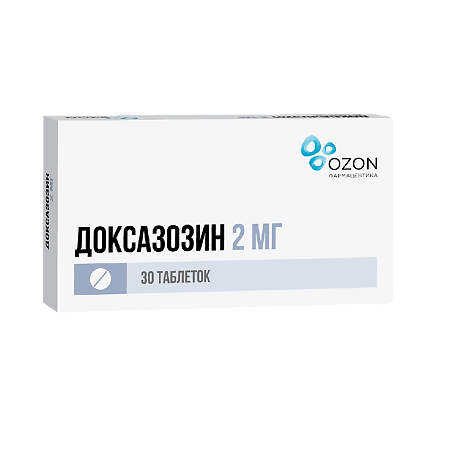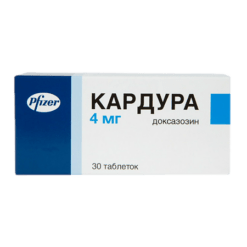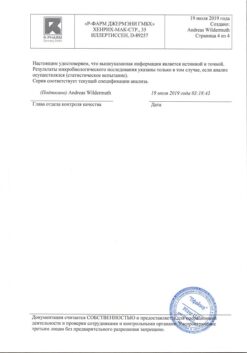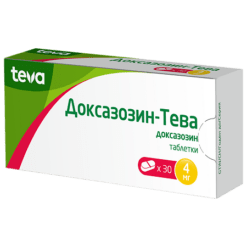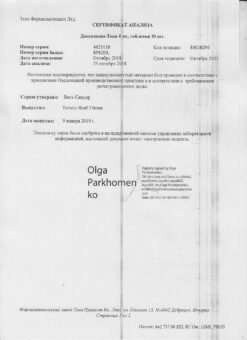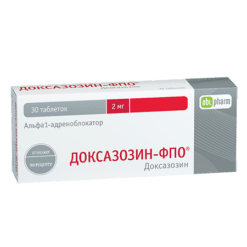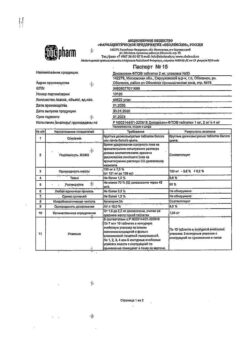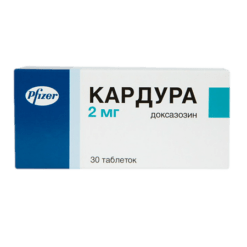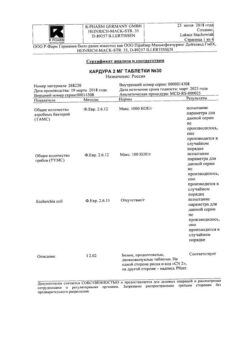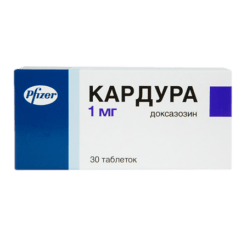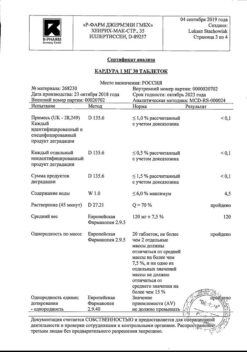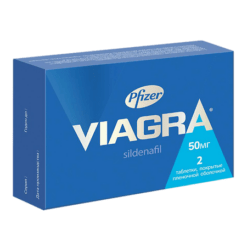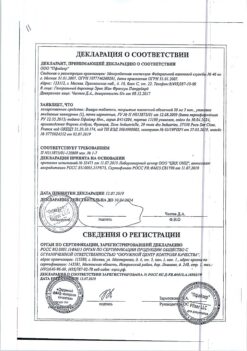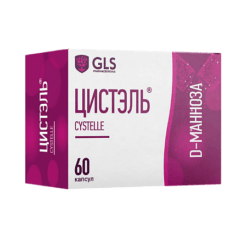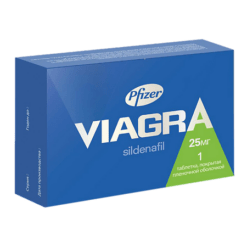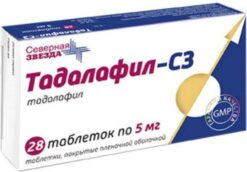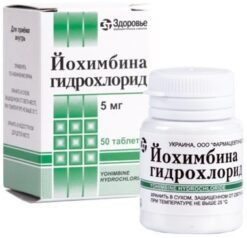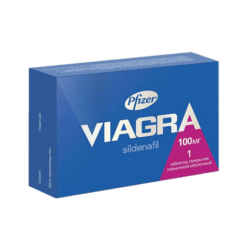No products in the cart.
Doxazosin, tablets 2 mg 30 pcs
€6.66 €5.83
Description
Pharmacotherapeutic group
alpha1-adrenoblocker
ATC code
C02CA04
Pharmacodynamics:
Benign prostatic hyperplasia
Prescribing doxazosin to patients with symptoms of benign prostatic hyperplasia (BPH) leads to significant improvement in urodynamic parameters and reduction of manifestations of symptoms of the disease. This action of the drug is explained by selective blockade of α-adrenoreceptors located in the stroma and capsule of the prostate and the urinary bladder neck.
Doxazosin has been proven to be a blocker of α1-adrenoreceptors of subtype 1A, which represent approximately 70% of all α1-adrenoreceptor subtypes present in the prostate. This explains its action in patients with BPH.
The maintenance effect of doxazosin treatment and its safety have been proven with long-term use of the drug (e.g., up to 48 months).
The use of doxazosin in patients with arterial hypertension leads to a significant decrease in blood pressure (BP) as a result of reduction of total peripheral vascular resistance. The appearance of this effect is associated with selective blockade of alpha1-adrenoreceptors located in the vascular network. When administered once daily, a clinically significant antihypertensive effect is maintained for 24 hours, BP decreases gradually; the maximum effect is usually observed 2-6 hours after oral administration. In patients with arterial hypertension, BP during doxazosin treatment was similar in “lying” and “standing” positions.
It was noted that in contrast to non-selective alpha1-adrenoblockers, long-term treatment with doxazosin did not develop tolerance to the drug. Increase of plasma renin activity and tachycardia are uncommon during maintenance therapy.
Doxazosin has favorable effect on blood lipid profile, increasing the ratio of high density lipoproteins to total cholesterol and significantly decreasing total triglycerides and total cholesterol concentration. In this regard, it has an advantage over diuretics and beta-adrenoblockers, which do not affect these parameters favorably.
With consideration of the established association of arterial hypertension and blood lipid profile with coronary heart disease, normalization of BP and lipid concentrations with doxazosin leads to decreased risk of coronary heart disease.
It was observed that doxazosin treatment resulted in regression of left ventricular hypertrophy, inhibition of platelet aggregation and increased activity of tissue plasminogen activator. In addition, doxazosin was found to increase insulin sensitivity in patients with impaired glucose tolerance.
Doxazosin has no metabolic side effects and can be used in patients with bronchial asthma, diabetes, left ventricular insufficiency and gout.
In vitro studies have demonstrated the antioxidant properties of 6′ and 7′-hydroxymetabolites of doxazosin at a concentration of 5 μmol.
In controlled clinical studies conducted in patients with arterial hypertension, treatment with doxazosin was accompanied by improvement of erectile function. In addition, patients treated with doxazosin had less recurrence of erectile dysfunction than patients treated with hypotensive agents.
Pharmacokinetics:
Doxazosin is well absorbed (80-90%) after oral administration at therapeutic doses; its concentration in blood reaches a maximum in about 2 h.
Doxazosin is approximately 98% bound to plasma proteins.
Doxazosin undergoes active biotransformation in the liver. Metabolites have no pharmacological activity; bioavailability is 69-70% (presystemic metabolism). The primary pathways of metabolism of doxazosin are O-demethylation and hydroxylation.
The plasma excretion is biphasic with a terminal elimination half-life of 22 h, which allows the drug to be administered once daily. Most of the doxazosin taken orally is excreted as inactive metabolites through the intestine less than 5% of the dose is excreted unchanged.
Pharmacokinetics in special clinical cases
According to pharmacokinetic studies in elderly patients and patients with renal failure pharmacokinetics of doxazosin is not significantly different from that in younger patients with normal renal function.
There are only limited data on pharmacokinetics in patients with impaired hepatic function and on the effects of drugs that can alter hepatic metabolism (e.g., cimetidine). In a clinical study in 12 patients with moderate hepatic impairment a single use of doxazosin was accompanied by a 43% increase in AUC (area under the curve “concentration-time”) and a 40% decrease in true oral clearance.
Caution should be exercised when prescribing doxazosin as well as other drugs (agents fully biotransformed in the liver in patients with impaired liver function.
Indications
Indications
– Benign prostatic hyperplasia: both in the presence of arterial hypertension and normal BP.
– Arterial hypertension: in combination with other hypotensive agents (thiazide diuretics beta-adrenoblockers slow calcium channel blockers or angiotensin-converting enzyme (ACE) inhibitors).
Active ingredient
Active ingredient
Composition
Composition
Active ingredient: doxazosin mesylate – 2.43 mg, in terms of doxazosin – 2.00 mg.
Excipients: lactose monohydrate (milk sugar) – 71.07 mg, microcrystalline cellulose – 20.00 mg, sodium carboxymethyl starch – 3.00 mg, povidon-K25 – 2.40 mg, magnesium stearate – 1.00 mg, sodium lauryl sulfate – 0.10 mg.
How to take, the dosage
How to take, the dosage
The drug Doxazosin can be administered both in the morning and in the evening and is intended to be taken orally. It is taken once a day regardless of meals. The tablet should be swallowed without chewing and with plenty of water.
Benign prostatic hyperplasia
The recommended starting dose of Doxazosin is 1 mg once daily to minimize the possibility of orthostatic hypotension and/or fainting. Depending on individual urodynamic parameters and the presence of symptoms of BPH, the dose may be increased to 2 mg and then to 4 mg up to a maximum daily dose of 8 mg. The recommended interval for increasing the dose is 1-2 weeks. Usually the recommended maintenance dose is 2-4 mg once daily.
Arterial hypertension
The dosage varies from 1 to 16 mg/day. Treatment is recommended to start with an initial dose of 1 mg once daily before bedtime. After the first dose, the patient should stay in bed for 6-8 hours. This is required due to the possibility of development of “first dose” phenomenon especially pronounced against the background of previous diuretics administration.
In case of insufficient therapeutic effect, the daily dose may be increased to 2 mg after 1-2 weeks. Thereafter, every 1 to 2 weeks the dose may be increased by 2 mg. In the vast majority of patients the optimal therapeutic effect is achieved at a dose of 8 mg per day. The maximum daily dose of 16 mg per day should not be exceeded. After achieving a stable therapeutic effect, the dose is usually withdrawn (the average therapeutic dose for maintenance therapy is usually 2-4 mg daily).
If a diuretic or other hypotensive agent is added to therapy, the dose of Doxazosin should be adjusted according to the patient’s condition with further titration under medical supervision.
In elderly patients and patients with impaired renal function, it is recommended to prescribe Doxazosin in normal doses.
Patients with impaired hepatic function require careful selection of doses of the drug. There are insufficient clinical data on the use of Doxazosin in patients with severe hepatic impairment (see section “Contraindications”).
Interaction
Interaction
Co-administration of Doxazosin with FDE-5 inhibitors in some patients may lead to symptomatic arterial hypotension.
Doxazosin should not be used concomitantly with other alpha1-adrenoreceptor blockers.
The majority (98%) of doxazosin in blood plasma is bound to proteins. The results of human plasma in vitro studies indicate that doxazosin does not affect the binding to proteins of digoxin warfarin phenytoin or indomethacin.
In clinical practice, doxazosin has been used without any evidence of interaction with thiazide diuretics furosemide beta-adrenoblockers antibiotics hypoglycemic oral uricosuric agents anticoagulants nonsteroidal anti-inflammatory agents. However, no official studies on the interaction of these drugs have been conducted.
Doxazosin potentiates the antihypertensive effect of other hypotensive agents.
Estrogens sympathomimetics may decrease the antihypertensive effect of doxazosin.
No adverse interaction has been noted with concomitant use of doxazosin with slow calcium channel blockers and angiotensin-converting enzyme inhibitors.
Doxazosin may decrease blood pressure and vascular responses to dopamine ephedrine epinephrine metharaminol methoxamine phenylephrine.
The interaction of doxazosin with drugs affecting hepatic metabolism has not been studied. In single use of doxazosin 1 mg per day for 4 days at simultaneous use of 400 mg cimetidine 2 times per day there was 10% increase of mean values of AUC and statistically insignificant increase of mean values of Cmax (maximum concentration in plasma) and mean half-life of doxazosin. Similar 10% increase of average AUC values of doxazosin on cimetidine administration is within variability (27%) of average AUC values for doxazosin in comparison with placebo.
Special Instructions
Special Instructions
As with any alpha-adrenoblocker treatment, especially at the beginning of therapy, orthostatic hypotension manifested by dizziness and weakness or loss of consciousness (fainting) may occur in a small number of patients (see section “Dosage and administration”). In this regard, it is necessary to monitor BP at the beginning of therapy to minimize the likelihood of orthostatic effects. Before the treatment with Doxazosin, patients should be warned about how to avoid symptoms of orthostatic hypotension, especially to avoid abrupt body position changes. At the beginning of treatment with Doxazosin, the patient should be advised to be cautious in case of weakness or dizziness.
In patients with arterial hypertension with one or more cardiovascular risk factors, Doxazosin should not be used as first-line therapy in monotherapy due to a possible increased risk of heart failure.
Patients should be monitored at the start of therapy or when increasing the dose to minimize possible postural effects such as: arterial hypotension syncope.
The treatment of patients with BPH with Doxazosin should be preceded by the exclusion of prostatic malignancy or other causes of urinary retention.
The risk of dizziness, visual disturbances, and fainting increases with age in elderly patients. Patients should be informed about the increased risk of orthostatic hypotension when drinking alcohol, standing or exercising for long periods of time, and when it is hot.
The regular monitoring of BP is recommended.
Because the drug has a vasodilator effect, caution should be exercised when prescribing for patients with heart conditions that require emergency treatment: pulmonary edema due to aortic or mitral stenosis right ventricular failure due to pulmonary embolism or exudative pericarditis left ventricular failure with low ventricular filling pressure; in patients with severe myocardial ischemia too rapid or pronounced BP reduction may lead to increased symptoms of angina.
Particular caution should be exercised when prescribing Doxazosin to patients with impaired liver function, especially in cases when concomitant use of drugs that may adversely affect liver function. In cases of worsening of liver function parameters, the drug should be immediately discontinued. It is not recommended to use doxazosin in patients with severe hepatic impairment due to insufficient experience of use (see sect. “Contraindications”).
Doxazosin may affect plasma renin activity and renal excretion of vanillylmindalic acid. This should be taken into account in laboratory studies.
Cautiousness should be observed when concomitant use of Doxazosin with thiazide diuretics or other hypotensive agents; the dose of Doxazosin should be reduced if combined therapy is necessary.
When concomitant use of doxazosin with FDE-5 inhibitors (e.g., sildenafil vardenafil tadalafil udenafil), caution should be used because both drugs have a vasodilator effect and may lead to symptomatic arterial hypotension in some patients. To reduce the risk of orthostatic hypotension, treatment with FDE-5 inhibitors is recommended to be started only if hemodynamic parameters of the patient are stabilized during the use of alpha-adrenoblockers. In addition, treatment with FDE-5 inhibitors should be started with the lowest possible dose and a 6-hour interval between doses of Doxazosin.
In some patients who were previously on tamsulosin, “intraoperative flabby iris syndrome” (ISDR, a variant of “narrow pupil” syndrome) has been noted during cataract surgery.
Separate reports have also been reported with other alpha1-adrenoreceptor blockers, so a possible effect of this drug class cannot be excluded.
The use of alpha1-adrenoceptor blockers should be advised to an ophthalmic surgeon when undergoing surgery (for cataracts).
Doxazosin has no effect on plasma concentrations of prostate-specific antigen (PSA).
When taking this medicine, refrain from driving motor vehicles and engaging in potentially dangerous activities requiring increased concentration and quick psychomotor reactions.
Contraindications
Contraindications
Hypersensitivity to doxazosin other quinazoline derivatives (including prazosin terazosin) or to any of the drug’s excipients other alpha-adrenoblockers; orthostatic hypotension (including a history of in anamnesis) chronic urinary tract infections urinary stone disease anuria concomitant urinary tract obstruction progressive renal insufficiency; severe hepatic insufficiency (experience of use is insufficient); breast-feeding period (when treating arterial hypertension) age less than 18 years (effectiveness and safety not established); lactose intolerance lactase deficiency and glucose-galactose malabsorption syndrome.
Additional symptomatic therapy of BPH on indication: urinary incontinence due to bladder overflow arterial hypotension.
Ischemic heart disease or other heart conditions: pulmonary edema due to aortic or mitral stenosis heart failure with high cardiac output right ventricular failure due to pulmonary embolism or exudative pericarditis left ventricular failure with low ventricular filling pressure (see See section “Special Precautions”).
Simultaneous use with phosphodiesterase 5 (PDE-5) inhibitors, including sildenafil tadalafil vardenafil and udenafil.
Diabetic autonomic neuropathy mild to moderate hepatic impairment; advanced age.
In case of cataract surgery.
Side effects
Side effects
The frequency of side effects is classified according to the recommendations of the World Health Organization as: very common (â¥1/10) common (â¥1/100 < 1/10) infrequent (â¥1/1000 < 1/100) rare (â¥1/10000 < 1/1000) very rare (< 1/10000) including single cases frequency is unknown (cannot be calculated based on available data).
Infectious and parasitic diseases: often – respiratory tract infections urinary tract infections.
Blood and lymphatic system disorders: very rarely – decreased number of leukocytes, platelets and red blood cells.
As to metabolism and nutrition: infrequent – thirst hypokalemia gout increase in body weight; rare – hypoglycemia very rare – increase in blood urea concentration.
Psychiatric disorders: infrequent – agitation anxiety insomnia anxiety depression.
Nervous system: often – drowsiness headache dizziness; infrequent – hypoesthesia tremor fainting cerebral circulatory disorders; very rare – paresthesia orthostatic dizziness.
Or vision: very rarely – blurred vision; frequency unknown – intraoperative atonic iris syndrome (variant of “narrow pupil” syndrome).
Hearing organ: frequently – vertigo; infrequently – tinnitus.
Cardiovascular system: often – feeling of palpitations tachycardia; infrequent – angina pectoris myocardial infarction; very rare – bradycardia arrhythmia.
Vascular disorders: often – a marked decrease in BP orthostatic hypotension; very rare – “rushes” of blood to the face.
Respiratory system: frequent – dyspnea rhinitis cough bronchitis; infrequent – nasal bleeding; very rare – bronchospasm.
Gastrointestinal system: frequently – abdominal pain dry mouth nausea dyspepsia; infrequently – constipation flatulence diarrhea vomiting gastroenteritis.
Hepatic and biliary tract disorders: rare – increased activity of “liver” enzymes; very rare – cholestasis hepatitis jaundice.
The skin: often – skin itching; infrequent – skin rash; very rare – purpura alopecia urticaria.
Skeletal-muscular system and connective tissue: often – back pain myalgia; infrequent – arthralgia; rarely – muscle cramps muscle weakness.
Recreational and urinary tract: frequent – cystitis incontinence; infrequent – frequent urination dysuria hematuria; rare – polyuria; very rare – nycturia increased daily diuresis.
Reproductive system: infrequent – erectile dysfunction; very rare – gynecomastia priapism; frequency unknown – retrograde ejaculation.
Others: common – asthenia peripheral edema chest pain flu-like syndrome; infrequent – facial edema pain of various localizations; very rare – increased fatigue malaise.
Overdose
Overdose
Symptoms: headache dizziness loss of consciousness dyspnea marked decrease in blood pressure sometimes accompanied by fainting sensation of palpitations tachycardia arrhythmia nausea vomiting possible hypoglycemia hypokalemia.
Treatment: symptomatic therapy. Monitoring of blood pressure. Binding of doxazosin to plasma proteins is high so dialysis is ineffective.
Pregnancy use
Pregnancy use
Although in animal experiments doxazosin had no teratogenic effect, a decrease in fetal survival was observed when it was used at exceptionally high doses. Therefore, despite the absence of teratogenic and embryotoxic effects according to experimental studies doxazosin may be prescribed in pregnancy only if the benefit to the mother exceeds the potential risk to the fetus or newborn.
Animal studies have shown that doxazosin accumulates in the milk of lactating rats.
It is not known whether doxazosin is excreted with breast milk. Breastfeeding should be discontinued if it is necessary to use Doxazosin during lactation.
Similarities
Similarities
Additional information
| Shelf life | 3 years. Do not use after the expiration date. |
|---|---|
| Conditions of storage | In the dark place at a temperature not exceeding 25 °С. Store out of the reach of children. |
| Manufacturer | Ozon, Russia |
| Medication form | pills |
| Brand | Ozon |
Other forms…
Related products
Buy Doxazosin, tablets 2 mg 30 pcs with delivery to USA, UK, Europe and over 120 other countries.

